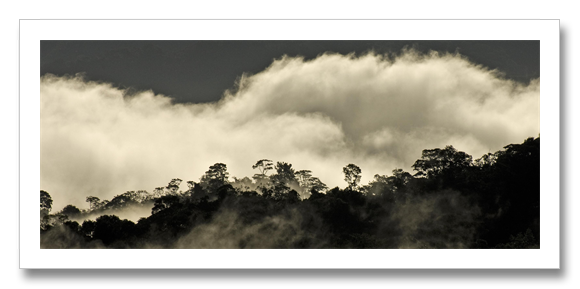In 2005, the Amazon had a one-hundred year drought. An event like this is basically supposed to be once in a hundred-year occurrence. Five years later they had another. But the 2010 drought was likely more than half again as extreme as the 2005 drought.
We can not say with scientific certainty that because we have had these two rare events in such close proximity that it is because of climate change. But a scientific certainty is something different from a moral or ethical certainty. Because there is no statistically valid answer for a data set with two points, does not mean that the assumption is false.
What has been projected in the models is happening now. Drought is rapidly increasing in the Amazon. The rain forest is dying off. As the dead trees decay, they are emitting more greenhouse gases than the remaining live ones absorb. The 2005 event alone was devastating to the Amazon forest. But the death of trees is just the beginning. What does this mean for the critical climate control system that is the Amazon rain forest?
The greenhouse gas emissions from the Amazon now, all of the Amazon – every year – are equivalent to about 13 billion tons of carbon dioxide. This is about 70 percent of the CO2 the United States emits every year.
The authors of this paper in the journal Science say: “Having two events of this magnitude in such close succession is extremely unusual, but is unfortunately consistent with those climate models that project a grim future for Amazonia.” They go on to talk about the likelihood that the 2010 drought was enhanced by the 2005 drought because trees were still stressed and may have succumbed more easily.
What happens in a tree-killing drought such as the 2005 event is that dry soils kill the root hairs on tree roots first. This destroys the trees ability to soak up water and if severe enough, the tree dies. It can take a decade for trees to regrow their root hairs. The least amount of stress can push them over the threshold and they die, years after the original drought, because of damage sustained during the original drought.
Dr. Lewis at Leeds University in the UK told me that the forest will regain its status as a carbon sink in a decade if another big drought does not happen during this time, and that the likelihood of more and bigger droughts is of course predicted to happen.
But I think that the really important thing to consider here is the philosophical road we as a society need to follow. Are we going to wait on the science, or make judgments on a multitude of events occurring faster and with more severity, that have been projected to happen on a warmer planet? Are we going to sit idly by while vested interest continue to claim their scanty publications prove there is doubt, or are we going to
They also tell us that their analysis does not consider forest fires caused by the drought conditions. And for context, the United States emitted 17.5 billion tons of C02 in 2010.
In an article in the U.K. Guardian, Lewis is quoted as saying the number of trees that died in the 2010 drought alone “in the low billions of trees.”
These researchers from the University of Leeds in the UKL estimate that the 2010 drought will be responsible for 8 billion tons of greenhouse gases. The Amazon biosystem normally sequesters 1.5 billion tons per year. Along with the 2005 drought, the Amazon forest was responsible 13 billion tones of emissions, or will be over the next dozen or so years as the trees decay.
FYI Amazongate – From our friends the climate deniers: Dr. Lewis was responsible for the science referred to by the IPCC in the so-called Amazongate affair. The Guardian in the United Kingdom accused the IPCC of referencing a World Wildlife Foundation (WWF) report saying that 40% of the Amazon could be impacted by climate change. The insinuation here is that the WWF report was not a peer reviewed scholarly source. Well, it seems that the WWF, in the paper referenced by the IPCC, had referenced Dr. Lewis’s work appropriately. The references is valid, the IPCC committed a Scribner’s error. The world has lost confidence in climate science because of climate denier fraud. Every single climategate controversy has been cleared, but vindication by multiple boards of inquiry does not make the evening news like a fast breaking climate scandal.
The 2010 Amazon Drought by Simon L Lewis, Paulo M Brando, Oliver L Phillips, Geertje MF van der Heijden and Daniel Nepstad is published in the journal Science on Friday 4 February 2011 http://www.sciencemag.org/content/331/6017/554.abstract . Press Release: http://www.leeds.ac.uk/news/article/1466/
Guardian Article http://www.guardian.co.uk/environment/2011/feb/03/tree-deaths-amazon-climate
Phillips, O. L. et al. Drought Sensitivity of the Amazon Rainforest, Science 323, 1344-1347 (2009).
Marengo, J. A., et al., The Drought of Amazonia in 2005, Journal of Climate, 21, 495-516.

